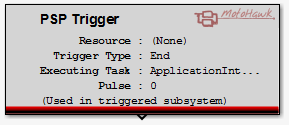PSP Trigger
This MotoHawk™ block passes execution control to the application when the selected resource either starts or completes a specified pulse.
Block ID
PSP Trigger
Library
MotoHawk_lib/Advanced Digital I/O
Description
This MotoHawk™ block passes execution control to the application when the selected resource either starts or completes the specified pulse. The "gating" trigger pulse specification can be associated to a Data Storage Definition to allow runtime control of the trigger's execution.
Classic targets do not support this block, but can use the less capable PSP End Trigger block.
This block, when referencing a resource defined via a Injector Sequence definition, is only supported only when selecting the standard injection sequence type setting.
This block, when referencing a resource defined via a Spark Sequence definition, is only supported when selecting standard and batch sequence types.
Block Parameters
| Parameter Field | Values | Comments/Description |
|---|---|---|
| Trigger Name | Alpha-numeric text, single-quote enclosed | Set the text that will be appended to code generated function name. This is useful when using a difference tool to compare the difference from one build to another. If this is left as an empty cell the appended value will be generated at build time, and can change from build to build. |
| Resource | Drop-down list | The resource that this trigger will be associated with |
| Execution Order within Task (lower executes first) | Numeric (Integer) | More than one trigger may be placed in a model that is driven by the same event. Use the Execution Order within Task attribute to define the execution order of these triggers relative to one another. The triggers will execute from the lowest Execution Order within Task value to the highest. |
| Trigger Pulse Specification Method | Dropdown |
Specifies how the "gating" trigger pulse is to be specified (Value, Scalar Datastore, Vector Datastore). Value allows design time specification of the triggering pulse, whilst the Datastore options will allow runtime specification. |
| Pulse Number (zero based) | Integer | Visible when the Trigger Pulse Specification Method is Value, this attribute specifies which PSP pulse generated by the specified resource will invoke the trigger's execution. Setting negative will allow all of the resource's pulses to trigger execution. |
| Reference Datastore Name | Alpha-numeric text, single-quote enclosed | Visible when the Trigger Pulse Specification Method is either Scalar Datastore or Vector Datastore, this attribute specifies the Data Storage Definition that is to be used to specify the PSP pulse generated by the specified resource that will invoke the trigger's execution. The datastore must be a signed integer type. The value referenced by the datastore is a zero based pulse index and a negative value implies all pulses generated by the specified resource are to invoke the trigger. Trigger execution will not occur if the value referenced by the datastore does not correspond to a valid pulse index. This behavior could be used to disable trigger execution when it is not required. |
| Datastore Offset | Zero based index | Visible when the Trigger Pulse Specification Method is Vector Datastore, this attribute specifies what vector element of the referenced datastore is to be used to specify the PSP pulse that will invoke the trigger's execution. |
| Reference Task Name | Alpha-numeric text, single quote enclosed | Identifies the task that this trigger will be executed within. When the application does not define its own tasks then use 'BGNDTask', 'FGNDTask', 'ApplicationInterruptTask' or the 'MainAppTask'. |
| Allow placement of trigger inside another triggered subsystem | Check box (enable) | Allows Simulink to simulate this trigger when it is inside another triggered subsystem. |

